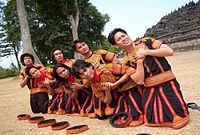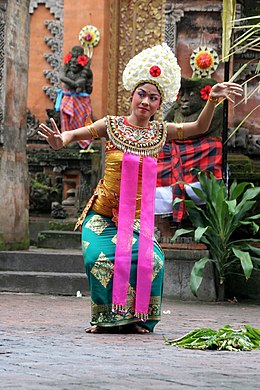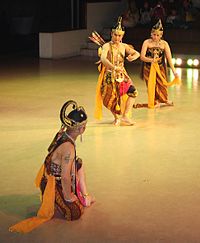Dance in Indonesia
From Wikipedia, the free encyclopedia
Dance in Indonesia (
Indonesian:
Tarian Indonesia) reflects the country's diversity of
ethnicities and
cultures. There are more than 700 ethnic groups in Indonesia:
Austronesian roots and
Melanesian
tribal forms are visible, and influences ranging from neighboring Asian
and even western styles through colonization. Each ethnic group has
their own dances; makes total dances in Indonesia are more than 3000
Indonesian original dances. The old traditions of dance and drama are
being preserved in the many dance schools which flourish not only in
the courts but also in the modern, government-run or supervised art
academies.
[1]
For classification purpose, the dances of Indonesia can be divided
according to several aspects. In historical aspect it can be divided
into three eras; the prehistoric-tribal era, the Hindu-Buddhist era and
the era of Islam. According to its patrons, it can be divided into two
genres; court dance and folk dance. In its tradition, Indonesian dances
can be divided into two types; traditional dance and contemporary dance.
In
Bali on November 19, 2011
UNESCO will announce the traditional
Saman dance from
Aceh
province as a world intangible cultural heritage. Saman dance is unique
due to there are no music instrument accompany the dance and just only
sing and clap their hands together to create harmony in movement and
sound.
[2]
[edit] Historical eras
[edit] The Prehistoric Tribal Era

Kabasaran dance,
Minahasa North Sulawesi.
Prior to their contact with the outer world the people of the
Indonesian archipelago had already developed their own styles of
dancing, still somewhat preserved by those who resist outside
influences and choose tribal life in the interior of Sumatra (example:
Batak,
Nias,
Mentawai), of Kalimantan/Borneo (example:
Dayak, Punan, Iban), of Java (example: Badui), of Sulawesi (example:
Toraja,
Minahasa), of the Moluccan Islands and of
Papua (example: Dani, Amungme).
Dances in Indonesia is believed by many scholars to have had its beginning in rituals and religious worship.
[3] Such dances are usually based on rituals, like the war dances, the dance of
witch doctors, and dance to call for rain or any agricultural related rituals such as
Hudoq dance ritual of Dayak people. Others are inspired by nature, such as the
Tari Merak (Peafowl dance) of
West Java. Ancient forms are usually characterized by repetitive movements like the
Tor-Tor dance of the
Batak people of (
North Sumatra).
The dancing also is meant to let the human's inner spirit come out, and
also to calm or appease the spirits. Some of the tribal dances
involving
trance mental condition which interpreted as channeling the spirits through the dancer's body movements.
Tari Sanghyang Dedari is a special dance of
Bali, in which the dancers are pre-pubescent girls in trance, chasing away bad spirits. The dance of
kuda lumping and
keris dance also involve trance.
[edit] The Hindu-Buddhist Era
With the advent of Dharmic religions in Indonesia, Hinduism and
Buddhism were celebrated in ritual and in art. They incorporated
stories of the
Ramayana,
Mahabharata and also
Panji cycles
into dance-drama, which is called "Sendratari" (dance-drama) or
sometimes simply translated as "ballet". Highly stylized methods of
dances were developed and are still obvious nowadays, especially in the
islands of Java and Bali. The Javanese Ramayana dance-drama is
regularly staged and performed in 9th century
Prambanan temple compound, Yogyakarta; while its Balinese counterpart is also performed in various
Balinese temples throughout the island. The Javanese
wayang orang
dance-drama took stories from the episodes of Ramayana or Mahabharata
Hindu epic. However, the dances are distinct to those of Indian. While
hand gestures are still very important, Indonesian dancers do not have
the Indian attention to
mudra:
instead the dances incorporated local forms. Javanese court dances
stressed on graceful and slow movements while the dances of Balinese
court are more dynamic and very expressive. The Javanese sacred ritual
dance of
Bedhaya is believed to have its root in 14th century
Majapahit court or probably earlier, which originated as ritual dance performed by virgins to worship
Indic deities such as
Shiva,
Brahma, and
Vishnu.
In Bali, dances has become the integral part of Hindu Balinese
rituals. Experts believed that balinese dance derived from older dance
tradition of Java. Friezes on East Javanese temples built during the
14th century show headdresses almost identical to those still being
used for dances in Bali today. These represent a remarkable unbroken
continuity of form at least 600 years old. Certain sacred dances are
reserved and only performed during certain religious ceremony. Each
Balinese dances have special functions, from sacred ritual dances
performed only in
Balinese temples, dance drama that retold the legends and popular stories, to dance for welcoming guests such as
pendet. The
topeng dance also popular in Java and Bali, it often took story from Panji tales, originated from 12th century
Kediri kingdom. The notable topeng dances are topeng Cirebon dance and topeng Bali dance.
[edit] The Islamic Era

Saman Aceh dance performance.
As the new religion of Islam gradually penetrated the region when
the native and dharmic dances retained its popularity. Artists and
performers would still use the styles of the previous eras, making
changes in stories (which took an Islamic turn) and clothing (which
became more modest in respect of Islamic teachings). This change is
obvious in
Tari Persembahan from Jambi. The dancers are still adorned with the intricate gold of the Hindu/Buddhist era but the clothing is more modest.
The new era brought newer styles of dance:
Zapin dances of the
Malay people and Acehnese
Tari Saman
adopted dance styles and musics typical of Arabia and Persia, and
combined them with indigenous styles to form a newer generation of
dance in the era of Islam. The adoption of Persian and Arab musical
instruments, such as
rebana,
tambur, and
gendang drums that has become the main instrument in Islamic dances, as well as chant that often quotes Islamic chants.
[edit] Patrons
[edit] The court dances

Golek Ayun-ayun, a Javanese court dance of
Yogyakarta
The dances in Indonesia reflects its diverse and long history. Several royal houses; the
istanas and
keratons
still survived in some parts of Indonesia and become the haven of
cultural conservation. The obvious difference between courtly dance and
common folk dance traditions is the most evident in
Javanese dance.
Javanese stratified social class is reflected in its culture, where the
upper noble class are more concentrated and deeply concern with
refinement, spiritual and sophistication; while the commoners are
usually more interested in entertainment and social value of the dance.
As the result court dances are often have strict rules and disciplines
preserved through generations, while folk dances are more liberated and
open to any influences.
The royal patronage of arts and culture is often encouraged by the
palace institution as the guardian of their traditions. For example the
Sultans of
Yogyakarta Sultanate and Sunans of
Surakarta are known to create various Javanese court dances completed with
gamelan
composition to accompanied the dance. The palace court traditions also
evident in Balinese and Malay court which usually— just like
Java—imposed refinement and prestige. Sumatran Malay courtly culture
such as the remnant of Aceh Sultanate, Deli Sultanate in North Sumatra,
and South Sumatra Sultanate, are more influenced by Islamic culture,
while Java and Bali are more deeply rooted in their Hindu-Buddhist
heritage.
[edit] The folk dances
The dance in Indonesia demonstrate the social complexity and the
social stratifications of its people, it often reflect the social class
and also degree of refinement. According to its patron, the folk dances
is the dance that developed and fostered by common people, either in
the villages or in the cities, in contrast of court dance that is
developed through royal patronage. Indonesian folk dances is often
relatively free from strict rules nor disciplines, although certain
style of gestures, poses and movements still preserved. The commoners
folk dance is more concerned with social function and entertainment
value than rituals.
The Javanese
Ronggeng and
Sundanese Jaipongan
is the fine example of this common folk dance traditions. Both are
social dances that are more for entertainment purpose than rituals. It
often display movements that are considered inappropriate in refined
courtly dances, as the result, the common folk dances were often
mistakenly deemed too erotic or even too crude for court standard.
However this traditions is alive and well in contemporary Indonesia
since it is popular and supported by its people. Certain traditional
folk dances has been developed into mass dance with simple but
structurized steps and movements, such as Poco-poco dance from Minahasa
North Sulawesi, and Sajojo dance from
Papua.
[edit] Traditions
[edit] The traditional dance
Traditional dance of Indonesia reflect the rich diversity of
Indonesian people. The dance traditions in Indonesia; such as Balinese,
Javanese, Sundanese, Minangkabau, Palembang, Malay, Aceh and many other
dances traditions are age old traditions, yet also a living and dynamic
traditions. Certain traditional dances might be centuries old, while
some others might just created less than a decade ago. The creation of
a new dance choreography but still within the frame of respected dance
tradition and discipline is still possible. As the result, there is
some
kreasi baru (newly created) dances. The newly created
dance could be the rediscovery and the revival of lost old traditions
or a new interpretation, inspiration and exploration of traditional
dances.
The Art Schools in Indonesia such as
Sekolah Tinggi Seni Indonesia (STSI) in
Bandung,
Institut Kesenian Jakarta (IKJ) in
Jakarta,
Institut Seni Indonesia (ISI/Indonesian Art Institute) in
Denpasar,
Yogyakarta, and
Surakarta all are fostering and encouraging their student to explore the dance traditions in Indonesia. Certain festival such as
Bali Art Festival also known as the distinguished event for Balinese traditional dance choreographers to showcase their Balinese
kreasi baru dances.
[edit] The contemporary dance

Modern dance during music performance
Indonesian contemporary dance borrows influences from abroad, such as western
ballet and
modern dance.
In 1954, two artists from Yogyakarta — Bagong Kusudiarjo and
Wisnuwardhana — journeyed to the United States to study ballet and
modern dance with a number of dance companies. When they returned to
Indonesia in 1959 they brought with them a new artistic culture, which
changed the face of movement and choreography and introduced the idea
of individual expression to Indonesian dance.
[4]
The idea of dance as individual expression and artistic exploration
rejuvenate the tradition-based dance discipline of traditional
Indonesia, through exposure to artists from a wide range of cultural
and artistic backgrounds. Native traditional dance traditions often
influenced the contemporary dance in Indonesia, such as traditional
Javanese dance form, pose and poise often took place in contemporary
dances performances. International dance collaborations also possible
and often took place, such as the collaboration of
Noh Japanese dance with Balinese and Javanese dance theatre.
Indonesian modern dance also showcased in Indonesian showbiz, such
as the dance performance to accompany songs, music performances or
entertainment. Today with rapid
pop culture influences from abroad, especially United States, urban teen dances such as
street dances also gain popularity among Indonesian youngsters.











































